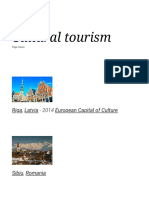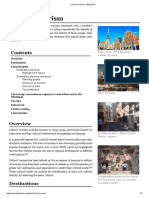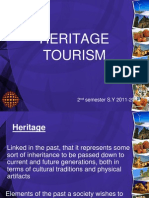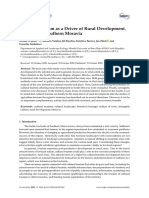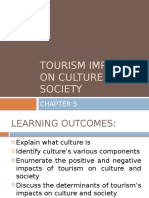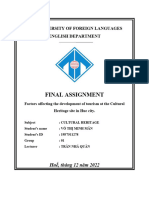0 ratings0% found this document useful (0 votes)
1 viewsHistorical
Historical
Uploaded by
maxx02277Copyright:
© All Rights Reserved
Available Formats
Download as PDF, TXT or read online from Scribd
Historical
Historical
Uploaded by
maxx022770 ratings0% found this document useful (0 votes)
1 views7 pagesCopyright
© © All Rights Reserved
Available Formats
PDF, TXT or read online from Scribd
Share this document
Did you find this document useful?
Is this content inappropriate?
Copyright:
© All Rights Reserved
Available Formats
Download as PDF, TXT or read online from Scribd
Download as pdf or txt
0 ratings0% found this document useful (0 votes)
1 views7 pagesHistorical
Historical
Uploaded by
maxx02277Copyright:
© All Rights Reserved
Available Formats
Download as PDF, TXT or read online from Scribd
Download as pdf or txt
You are on page 1of 7
Cultural tourism is a type of tourism in which the visitor's
essential motivation is to learn, discover, experience and
consume the cultural attractions and products offered by a
tourist destination. These attractions and products relate to
the intellectual, spiritual, and emotional features of a society
that encompasses arts and architecture, historical and
cultural heritage, culinary heritage, literature, music, creative
industries as well as the living cultures with their lifestyles,
value systems, beliefs and traditions.[1]
Overview
[edit]
Cultural tourism experiences include, but are not limited to,
architectural and archaeological treasures, culinary
activities, festivals or events, historic or heritage, sites,
monuments and landmarks, museums and exhibitions,
national parks and wildlife sanctuaries, and religious
venues. It includes tourism in urban areas, particularly
historic or large cities and their cultural facilities such
as theatres,[1] as well as tourism in remote, indigenous
regions. In the twenty-first-century United States, national
parks and a limited number of Native American councils
continue to promote "tribal tourism." The U.S. National Park
Service has publicly endorsed this strain of cultural tourism,
despite lingering concerns over exploitation and the
potential hazards of ecotourism in Native America.[2]
Proponents of cultural tourism say that it gives the local
population the opportunity to benefit financially from their
cultural heritage and thus to appreciate and preserve it,
while giving visitors the opportunity to broaden their
personal horizons. Cultural tourism also has negative sides.
There may be negative effects on local residents, such as
making the local economy unstable, increasing the cost of
living for local residents, increasing pollution, or
creating environmental problems. Also, the local population
is at risk of coming into contact with new ways of life that
can disrupt their social fabric.[3][4][5]
This form of tourism is becoming generally more popular
throughout the world, and a recent OECD report has
highlighted the role that cultural tourism can play in regional
development in different world regions.[6] Cultural tourism
has recently shifted towards meeting the growing desire for
cultural "experiences" in particular.
A decorated water well in Zalipie, Poland
Tourists at the cultural historical Old Town of Porvoo
Sectors of cultural tourism can be distinguished both by the
destination (urban cultural tourism, rural cultural tourism,
etc.) as well as the theme of the trip (heritage tourism,
popular culture tourism, etc.).[7] The main subcategories are
discussed in more detail below.
Subcategories of Cultural Tourism
[edit]
Heritage tourism
[edit]
Archaeological sites
Monuments
Architecture
Museums
Religious Sites
Heritage tourism involves traveling to a site of cultural
significance to engage with the heritage of the region and
local population. In recent years, more attention has been
put on the inclusion and thoughtful representation of the
history of marginalized groups for the tourist audience,
marked by UNESCO's updates to their World Heritage List,
which is a comprehensive list of significant heritage sites. [8]
Arts tourism
[edit]
Theater
Concerts and music venues
Galleries
Festivals, carnivals and events
Literary sites
Arts tourism involves traveling to the location of an art
exhibit, which includes live-performances, museums, and
libraries. Arts tourism is a relatively less common form of
cultural tourism, due both the historical exclusivity of the arts
scene, and the option for artists to go on tour, eliminating
the need for tourism. Even so, in recent years, the arts
community has put increased emphasis on prioritizing the
accessibility of local art and exhibits. [8]
Creative Tourism
[edit]
Photography
Painting
Pottery
Culinary arts
Language learning
Creative Tourism involves active participation from tourists
in cultural experiences specific to each holiday destination.
This form of tourism is more recently theorized and defined
by Greg Richards and Crispin Raymond in 2000. They
defined creative tourism as: "Tourism which offers visitors
the opportunity to develop their creative potential through
active participation in courses and learning experiences,
which are characteristic of the holiday destination where
they are taken." (Richards, Greg et Raymond, Crispin,
2000).
This type of tourism is opposed to mass tourism and allows
the destinations to diversify and offer innovative activities
different from other destinations.
Similarly, UNESCO launched in 2004 a program
entitled Creative Cities Network. This network aims to
highlight cities around the world that are putting creativity at
the heart of their sustainable urban development plan.
Creative cities are organized into seven categories
representing seven different creative fields: crafts and folk
arts, digital arts, film, design, gastronomy, literature, and
music. As of January 2020, the network has 246 members
across all categories. In order to promote the development
of this new type of tourism, a non-profit organization was
created in Barcelona in 2010: Creative Tourism Network. Its
missions involve, among others: the promotion of creative
tourism, the creation of a network of "Creativefriendly" cities
but also awards celebration, The Creative Tourism Awards."
Urban cultural tourism
[edit]
Historic cities
Regenerated industrial cities
Waterfront development
Arts and heritage attractions
Shopping
Nightlife
Urban cultural tourism involves traveling to urban sites of
cultural significance, which often offer a range of both
historical and recreational attractions. Certain major urban
cities with cultural offerings are listed in UNESCO's world
heritage site and have been lauded for their promotion of
cross-cultural exchange. Other urban cultural tourist sites
are post-industrial cities, who offer tourists a slice of their
history alongside modern recreation, such as shopping and
nightlife. [8]
Rural cultural tourism
[edit]
Village, farm or agro-tourism
Eco-museums
National parks
Wine trails
Rural cultural tourism involves traveling to rural sites of
cultural significance. Similarly to urban cultural tourist sites,
many rural sites are cities whose main industries have
declined, that supplement their economies by offering
various attractions, such as wine-tasting. Other rural cultural
sites have great historical significance, such as national
parks. [8]
Indigenous cultural tourism
[edit]
Hilltribe, desert or mountain trekking
Visits to cultural centers
Arts and crafts (by local artists)
Cultural performances
Festivals
Indigenous cultural tourism is defined as "any service or
product that is a) owned and operated at least in part by an
Indigenous group and b) results from a means of exchange
with outside guests."[9] Most indigenous community have
faced historic marginalization, which has led many
proponents of cultural tourism to emphasize the need for
sensitivity around these cultural events, as well as the
importance of the indigenous population's control over how
their culture is represented.[8] Experts recognize that "the
capitalization of Native identity has been a feature of Native
and European interaction since the early colonial
period."[9] However, although this legacy is perhaps echoed
by modern day indigenous tourism, involvement in the
tourism industry allows indigenous populations "[to take]
part in the global economy on their own terms."[9]
Popular cultural tourism
[edit]
Theme parks and themed attractions
Shopping malls
Pop concerts
Sporting events
Media and film sets
Industrial heritage sites
Fashion and design museums
Popular cultural tourism involves any kind of tourist
attractions that are modern and mainstream, such as
amusement parks or sporting events. Popular cultural
tourism has only recently been included under the umbrella
of cultural tourism, as recreational activities have gained
increasing recognition for their cultural significance.[8]
You might also like
- Managing Transitions, 25th Anniversary Edi - William BridgesDocument201 pagesManaging Transitions, 25th Anniversary Edi - William BridgesBreejum Portulum Brascus91% (11)
- Heritage Tourism: Safeguarding The Past by Making It Relevant TodayDocument28 pagesHeritage Tourism: Safeguarding The Past by Making It Relevant TodayGlory Jane BernardinoNo ratings yet
- PintoDocument8 pagesPintoblader johnNo ratings yet
- Derrett J Duncan M - Law in The New Testament - The Parable of Talents AndTwo LogiaDocument12 pagesDerrett J Duncan M - Law in The New Testament - The Parable of Talents AndTwo LogiaRINCONJTNo ratings yet
- Module 2-Cultural TourismDocument8 pagesModule 2-Cultural Tourismcarpioshane686No ratings yet
- Notes On Cultural Tourism, Cultural Mapping and Gis 1 Definitions of Cultural TourismDocument11 pagesNotes On Cultural Tourism, Cultural Mapping and Gis 1 Definitions of Cultural TourismNEEPANo ratings yet
- The Role of Gastronomy in Tourism Development-Greg RichardsDocument10 pagesThe Role of Gastronomy in Tourism Development-Greg RichardsEdmond-Cristian PopaNo ratings yet
- Cultural TourismDocument58 pagesCultural TourismIreneNo ratings yet
- Cultural and Heritage TourismDocument6 pagesCultural and Heritage TourismVeda DeshpandeNo ratings yet
- Conservation and Rehabilitation of Urban PDFDocument11 pagesConservation and Rehabilitation of Urban PDFPragnyaraj BisoyiNo ratings yet
- Analysis of The Main Romanian Cultural Tourism Products: ArticleDocument7 pagesAnalysis of The Main Romanian Cultural Tourism Products: ArticleGabita VascanNo ratings yet
- Effect of Culture On TravelDocument3 pagesEffect of Culture On TravelcotejoalexaNo ratings yet
- Cultural Tourism Definitions Resource 1Document3 pagesCultural Tourism Definitions Resource 1Anand S R VellanadNo ratings yet
- Defining Cultural TourismDocument9 pagesDefining Cultural TourismSheryl De LumenNo ratings yet
- Cultural Tourism1Document17 pagesCultural Tourism1karriskeahNo ratings yet
- Cultural Tourism WikipediaDocument22 pagesCultural Tourism WikipediaGrace SolibioNo ratings yet
- I J M E R: Cultural Tourism Dr. Vanaja UdayDocument4 pagesI J M E R: Cultural Tourism Dr. Vanaja UdayKamal KohliNo ratings yet
- Architectural TourismDocument35 pagesArchitectural TourismScribdTranslationsNo ratings yet
- Cultural Heritage TourismDocument2 pagesCultural Heritage TourismJessica PoolNo ratings yet
- Summary Heritage TourismDocument12 pagesSummary Heritage Tourismlaura99bonomiNo ratings yet
- Cultural TourismDocument44 pagesCultural TourismmaryadoNo ratings yet
- Cultural and Heritage Tourism: Concepts & PrinciplesDocument16 pagesCultural and Heritage Tourism: Concepts & PrinciplesLevirolfDeJesusNo ratings yet
- Cultural and Heritage TourismDocument15 pagesCultural and Heritage TourismVijaya Ratna MNo ratings yet
- Cultural Tourism - Wikipedia PDFDocument5 pagesCultural Tourism - Wikipedia PDFphyu trezaNo ratings yet
- доповідь про туризмDocument6 pagesдоповідь про туризмТетяна КубракNo ratings yet
- Kitsch and Cultural TourismDocument3 pagesKitsch and Cultural TourismArkantos TirbaNo ratings yet
- A. Balla G. Pavlogeorgatos D. Tsiafakis PDFDocument4 pagesA. Balla G. Pavlogeorgatos D. Tsiafakis PDFGeorgiaVoryllaNo ratings yet
- Sustainable Tourism and Culture: A Symbiotic RelationshipDocument14 pagesSustainable Tourism and Culture: A Symbiotic RelationshipIEREKPRESSNo ratings yet
- New Report (AutoRecovered)Document12 pagesNew Report (AutoRecovered)FATIMAHNo ratings yet
- Unit I - IntroductionDocument14 pagesUnit I - IntroductionReinaNo ratings yet
- Cultural and Heritage TourismDocument14 pagesCultural and Heritage TourismI Kadek Dwi Noorwatha100% (1)
- TT2 Cultural TourismDocument31 pagesTT2 Cultural TourismRasam RNo ratings yet
- Crafts and Tourism in BulgariaDocument7 pagesCrafts and Tourism in BulgariaIlinka TerziyskaNo ratings yet
- 2015 2 4 1 PenningsDocument14 pages2015 2 4 1 PenningsSome445GuyNo ratings yet
- Tourism Impacts On Culture and SocietyDocument18 pagesTourism Impacts On Culture and SocietyMia Grace Bautista100% (1)
- Contemporary IdentityDocument12 pagesContemporary IdentityRobert AlagjozovskiNo ratings yet
- Module 5 Tourism Impact On Culture and Society 1Document10 pagesModule 5 Tourism Impact On Culture and Society 1Dave GeronagaNo ratings yet
- Tourism ProductDocument11 pagesTourism ProductLavenderogre 24No ratings yet
- Cultural Impacts (Tourism)Document12 pagesCultural Impacts (Tourism)Anvesh VakadiNo ratings yet
- Cultural Tourism and Museums: Barry Lord, Vice PresidentDocument12 pagesCultural Tourism and Museums: Barry Lord, Vice PresidentNadira Dwiputri LaseNo ratings yet
- CHAPTER 5-Tourism Impacts On Culture and Society TM 4-3Document39 pagesCHAPTER 5-Tourism Impacts On Culture and Society TM 4-3John Maynard0% (1)
- Heritage and Culture TourismDocument10 pagesHeritage and Culture Tourismrebeca.garcia44No ratings yet
- Lesson 1 Heritage 2011Document14 pagesLesson 1 Heritage 2011Dominique AndrewNo ratings yet
- Cultural Tourism in Gjirokastra: Mimoza Kotollaku Magdalena Margariti, MSCDocument23 pagesCultural Tourism in Gjirokastra: Mimoza Kotollaku Magdalena Margariti, MSCandrawes222No ratings yet
- Inbound 5003262910826623288Document8 pagesInbound 5003262910826623288Aileen Velasquez BasaNo ratings yet
- Heritage TourismDocument8 pagesHeritage Tourismjisan.oscNo ratings yet
- Cultural Tourism As A Driver of Rural Development. Case Study: Southern MoraviaDocument16 pagesCultural Tourism As A Driver of Rural Development. Case Study: Southern Moraviafahim.gazyNo ratings yet
- TMD 3141 Chapter 04 2023Document21 pagesTMD 3141 Chapter 04 2023mukhawaadivhahoemmanuelNo ratings yet
- Creative Cultural Tourism As a New Model of the Relationship between Cultural Heritage and TourismDocument6 pagesCreative Cultural Tourism As a New Model of the Relationship between Cultural Heritage and Tourismbrios71097No ratings yet
- Chapter 5 - Tourism Impacts On Culture and SocietyDocument23 pagesChapter 5 - Tourism Impacts On Culture and Societyanon_16301208No ratings yet
- Tourism and CultureDocument16 pagesTourism and CultureJeffrey TuballaNo ratings yet
- A Study On Cultural Sustainable Tourism in Context of Painted ScrollsDocument7 pagesA Study On Cultural Sustainable Tourism in Context of Painted ScrollsIEREKPRESSNo ratings yet
- Tourism Cultural CN PDFDocument11 pagesTourism Cultural CN PDFStatache IonutNo ratings yet
- Lesson 3 - Culture HeritageDocument67 pagesLesson 3 - Culture HeritageBituin LynNo ratings yet
- mẫu tiểu luận DSVHDocument26 pagesmẫu tiểu luận DSVHbtrmnguyenhoangNo ratings yet
- Related Research Literature InternationalDocument7 pagesRelated Research Literature InternationalKharlyn MengoteNo ratings yet
- Micro Perspective eDocument10 pagesMicro Perspective ethgiewdgnanisNo ratings yet
- Heritage and Culture TourismDocument13 pagesHeritage and Culture TourismNoora Al Shehhi100% (2)
- Nataša Urošević Presentation Roskilde HP 2012 ConferenceDocument19 pagesNataša Urošević Presentation Roskilde HP 2012 Conferencenatasa_urosevic6511No ratings yet
- Thematic Routes Nagy KatalinDocument8 pagesThematic Routes Nagy KatalinMarija ObradovicNo ratings yet
- Use & Care Instructions: Automatic Stainless Steel PercolatorsDocument6 pagesUse & Care Instructions: Automatic Stainless Steel PercolatorsSteve FigueirasNo ratings yet
- NY Bar Review - Evidence Lecture NotesDocument31 pagesNY Bar Review - Evidence Lecture NoteswavygirlyNo ratings yet
- Reading Comprehension Part 4 Answers: QuestionsDocument1 pageReading Comprehension Part 4 Answers: QuestionsDan Paolo AlbintoNo ratings yet
- Контрольные задания к Enjoy English 2-4 классыDocument36 pagesКонтрольные задания к Enjoy English 2-4 классыАнастасия Токарева100% (1)
- Lesson PlanDocument6 pagesLesson Planapi-331867409No ratings yet
- Le Ngoc Phuong LinhDocument3 pagesLe Ngoc Phuong LinhNgọc Phương Linh LêNo ratings yet
- Unlock The Potential! Godrej Tropical Isle Floor PlanDocument9 pagesUnlock The Potential! Godrej Tropical Isle Floor PlanGodrej Tropical IsleNo ratings yet
- P InterestDocument9 pagesP InterestKhaledMAlsersyNo ratings yet
- Allocation TA 2023Document14 pagesAllocation TA 2023bhoopendrasinghrathore546No ratings yet
- Write It Upon The Tables of Their HeartsDocument3 pagesWrite It Upon The Tables of Their HeartsSonofManNo ratings yet
- Cost Analysis: Dr. Pushparaj Kulkarni Asst. Professor M. Com., MBA, ICWADocument27 pagesCost Analysis: Dr. Pushparaj Kulkarni Asst. Professor M. Com., MBA, ICWACma Pushparaj KulkarniNo ratings yet
- Connect Online and Offline Insights With Google Analytics 360 + Salesforce Sales CloudDocument3 pagesConnect Online and Offline Insights With Google Analytics 360 + Salesforce Sales Cloudfeisal0% (1)
- Walmart - Case StudyDocument2 pagesWalmart - Case Studyaravinthmai100% (1)
- Through Night and DayDocument4 pagesThrough Night and Dayqwerty heroNo ratings yet
- Dry Toilet 7th NenijoviDocument34 pagesDry Toilet 7th NenijoviMarsya Dyasthi PutriNo ratings yet
- 2022 GKS-G Application FormsDocument13 pages2022 GKS-G Application FormsAnouar SaouliNo ratings yet
- Fi CircularDocument3 pagesFi Circularmctraders111No ratings yet
- Pampers Brief Srilanka 2013Document22 pagesPampers Brief Srilanka 2013Faisal HashmiNo ratings yet
- ITFC - NGF Track 2 Compendium of Long-Form EssaysDocument95 pagesITFC - NGF Track 2 Compendium of Long-Form EssaysnidhiNo ratings yet
- Curriculum Vitae 2 - EnglishDocument2 pagesCurriculum Vitae 2 - EnglishAymen ZerguiniNo ratings yet
- Change My Heart Oh GodDocument1 pageChange My Heart Oh GodJanna Be AmoguisNo ratings yet
- How To Make Value-Based Care Work in CardiologyDocument29 pagesHow To Make Value-Based Care Work in CardiologyPat WilsonNo ratings yet
- Nairobi Youth Business Plan: See Beyond BordersDocument46 pagesNairobi Youth Business Plan: See Beyond Bordersxhumaz50% (2)
- Online Safety and Technology Working Group Final ReportDocument148 pagesOnline Safety and Technology Working Group Final ReportAdam ThiererNo ratings yet
- Evaluating Hospital Pharmacy InventoryDocument27 pagesEvaluating Hospital Pharmacy InventoryLegal DOHROIINo ratings yet
- Lesson 1-Culture and PsychologyDocument8 pagesLesson 1-Culture and PsychologyMaricris Gatdula100% (2)
- GSRP - Slope Protection DrawingsDocument5 pagesGSRP - Slope Protection DrawingskanagarajodishaNo ratings yet
- 09 Bbfa1103 T5Document37 pages09 Bbfa1103 T5djaljdNo ratings yet















